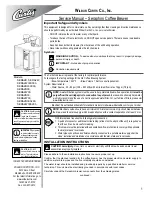
www.scheppach.com
+(49)-08223-4002-99
+(49)-08223-4002-58
13 І 72
www.scheppach.com
+(49)-08223-4002-99
+(49)-08223-4002-58
•
Wear firm, insulated footwear. Your shoes
should also protect you in wet conditions.
Opentoed footwear is not suitable since falling
droplets of glowing metal will cause burns.
•
Wear suitable clothing, do not wear synthetic
clothes.
•
Do not look into the arc with unprotected eyes,
use only a welding safety shield with the proper
safety glass in compliance with DIN standards.
In addition to light and heat, which may cause
dazzling and burns, the arc also gives off UV ra-
diation. Without proper protection, this invisible
ultraviolet radiation causes very painful con-
junctivitis, which will only be noticeable several
hours later. In addition, UV radiation will cause
sunburn-type symptoms on unprotected parts of
the body.
•
Personnel or assistants in the vicinity of the arc
must also be notified of the dangers and pro-
vided with the required protection; if necessary
install safety walls.
•
Ensure adequate ventilation for welding, particu-
larly in small rooms since the process causes
smoke and harmful gases.
•
Do not carry out any welding work on tanks that
have been used to store gases, fuels, mineral
oil or the like, even if they have been empty for
a lengthy period of time, since any residue will
result in a danger of explosion.
•
Special regulations apply in areas where there
is a potential risk of fire and/or explosion.
•
Welds that are exposed to large stresses and
must comply with safety requirements may only
be completed by specially trained and approved
welders. Examples of such welds include pres-
sure vessels, rails, trailer hitches, etc.
•
Note: It must be noted that the protective con-
ductor in electrical systems of appliances may
be destroyed by the welding current in the event
of negligence, for example if the earth terminal
is placed on the welding set casing to which the
protective conductor of the electrical system is
connected. The welding work is completed on a
machine with a protective conductor connection.
It is therefore possible to weld on the machine
without having connected the earth terminal to
it. In this case the welding current will flow from
the earth terminal through the protective con-
ductor to the machine. The high welding current
may cause the protective conductor to melt.
•
The fuses on the supply cables to the mains
sockets must comply with the relevant regula-
tions. To comply with these regulations, only
fuses or circuit breakers suitable for the cross-
section of the cables may be used. The use of
too high a fuse may result in the cable burning
and fire damage to the building.
Constricted and wet areas
When working in constricted, wet or hot areas, use
insulating supports and intermediate layers as well
as slip-on gloves made of leather or other noncon-
ductive materials to insulate your body against the
floor, walls, conductive parts of the machine and the
like.
•
Arc welding generates sparks, molten metal
particles and smoke, so the following is re-
quired: Remove all inflammable substances
and/or materials from the working area.
•
Ensure that there is adequate ventilation.
•
Do not weld on tanks, vessels or pipes that have
contained inflammable liquids or gases. Avoid
all direct contact with the welding circuit; the
idling voltage between the electrode tongs and
the earth terminal may be dangerous.
•
Do not store or use the appliance in wet or
damp conditions or in the rain.
•
Protect your eyes with specially designed gog-
gles (DIN Grad 9-10). Wear gloves and dry
safety clothing that are not contaminated by
any oil or grease to ensure that your skin is not
exposed to ultraviolet radiation from the arc.
•
Do not use this welder to defrost pipes
Remember!
•
The radiation from the arc can damage your
eyes and cause burns on skin.
•
Arc welding generates sparks and droplets of
molten metal; the welded workpiece may start
to glow and will remain very hot for a relatively
long period of time.
•
Arc welding releases vapors that may be harm-
ful. Every electric shock is potentially fatal.
•
Do not approach the arc within a radius of 15 m
unprotected.
•
Protect yourself (and others around you) against
the possible hazardous effects of the arc.
•
Warning: Depending on the mains connection
conditions at the connection point of the welding
set, other consumers connected to the mains
may suffer faults.
Important!
If the supply mains and circuits are overloaded,
other consumers may suffer interference during the
welding work. If you have any doubts, contact your
electricity supply company.
Sources of danger during arc welding
Arc welding results in a number of sources of
danger. It is therefore particularly important for the
welder to comply with the following rules so as not
to place himself or others in danger and to avoid
endangering people and equipment.
•
Have all work on the mains voltage system,
for example on cables, plugs, sockets, etc.,
performed only by trained electricians. This
particularly applies to configuring intermediate
cables.
•
If an accident occurs, disconnect the welding
power source from the mains immediately.
•
If electric touch voltages occur, switch off the
welding set immediately and have it checked by
an expert.
•
Always check for good electrical contacts on the
welding current side.
•
Wear insulating gloves on both hands for weld-
ing. These offer protection from electric shocks
(idling voltage in the welding circuit), harmful
radiation (Heat and UV radiation) and from
glowing metal and slag spatter.
GB














































